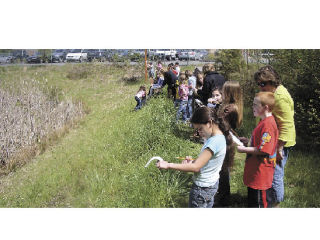In an era when public schools are more focussed on WASL exams than art, the teachers at Pioneer Elementary School have taken art into their own hands.
Thanks to third-grade teacher Beth Trafton, a loyal volunteer who emphasizes the importance of art for children, and art docent now gets paid a little for her efforts.
After 30 years of teaching, Sharon Olin retired in 1995, but since 2005 she has been spending at least two days a week at Pioneer teaching art.
Trafton is the one who sought a source of funds and wrote grant proposals to help pay a volunteer art docent.
Until recently, third- and fourth-grades alternated Thursday afternoon art projects. This year, the younger kids starting alternating Tuesdays.
The school’s hallway reflects Olin’s efforts, with goldfish paintings by first-graders, clay illustrations by second-graders and cubistic self-portraits by third-grade students.
“The goldfish are inspired by Henri Matisse,” Olin said. “And for the self-portraits, third-grade students learn about Pablo Picasso.”
Olin is assisted in her art classes by Heidi Ewing, a volunteer mother, who got interested in art when she was a student at Arlington High School taking ceramics with Mike Addington.
“I help set up and clean up and do whatever Sharon needs me to do. I help with the kids in need when Sharon is busy with others.”
“We went to Karl Olson, the principal, for his support of a Professional Growth Option project combining art with writing,” Trafton said.
Inspired by the school’s retention area, the young artists last year created books, drawing pictures of the plants in the wetlands. That book was paid for by a grant from the Snohomish County Surface Water Management. Now they are just finishing another book about the birds in the wetlands, paid for by a grant from Pilchuck Audubon Society.
Trafton attributes this year’s grant to another former teacher, Virginia Clark, who is an active bird watcher and member of the local chapter of the Audubon Society.
The students enjoyed some of the few sunny days this spring out in the wetlands sketching for their book project. They then went back into class to write about what they saw.
A student, Amanda Barentine, said she really enjoys the school’s art program.
“I enjoy sketching in the wetlands,” she said. “I like art. My favorite thing to sketch is elephants.”
The teachers feel strongly that art plays an important role in learning.
“We want our students to be educated in the arts,” Trafton said.
“The sketching helps kids in their science classes,” said Kathy Shoemaker, fourth-grade teacher. “They learn how to observe and see the details. They learn about the birds’ feathers and eggs, and how the wetlands function as the birds’ home.”
Shoemaker’s fourth-grade students study Native American art together with its social studies program and they enjoyed an opportunity to visit the Everett Center for the Arts to see an exhibit of Tulalip Tribes artists presented as an Art in Education program by the Arts Council of Snohomish County. To expand on the learning from the art projects, the students also write about their art and artists.
“We have to teach smarter,” Trafton admitted.
“We need to use the curriculum to touch on all subjects, including art and music as well as science and math.”
They even use art in social studies.
“We use paper mache to sculpt land forms in topographical maps. We make 3-D trees and plants, noticing the buds, trunks and branches and how they are formed.
“It helps the kids look at things closer.”
The teachers all agree that art especially helps kids who are visual, or hands-on learners. When they combine words with pictures, then art infuses into the instruction.
Another positive result of art is in relationships developed among the students.
“They appreciate each other’s work. The older kids mentor the younger kids and everyone is excited to see what the others are doing.
The teachers believe that behavior management has become easier since Olin has been spending time with their students.
“The kids have become very conscious of the art,” said Colleen Turk, second-grade teacher.
This art project is just one example of collaboration about teachers at Pioneer.
“Collaboration is our theme here,”
“It’s thanks to Beth that Sharon gets a little compensation for all her effort,” Turk said.
“Karl has also help a lot,” she added.
The background of art has contributed to the success of the wetland book project,”
The art project has developed since 2005, with the benefits becoming increasingly apparent.
“The art supplies stay out all the time, now,
Now that the kids are starting art in kindergarten, the results are huge by fourth-grade.
“We are starting to see the value of the continuity.”
“There is much less instruction on cleaning up now.”








